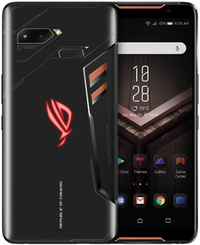Razer Phone 2 vs. ROG Phone: Which Gaming Phone Wins?
The Razer Phone 2 and Asus' ROG Phone both claim to offer the best mobile gaming experience. We put these gaming-focused phones head to head to find out which one rules.
This may turn out to be the year gaming phones break out. When the Galaxy Note 9 debuted in the summer, Samsung pitched the phone as the best mobile platform for playing Fortnite (among other talents). Huawei's budget brand, Honor, has a gaming phone of its own with the Honor Play — so named for its GPU Turbo feature, which kicks the device into high gear when you're playing graphics-intensive games.
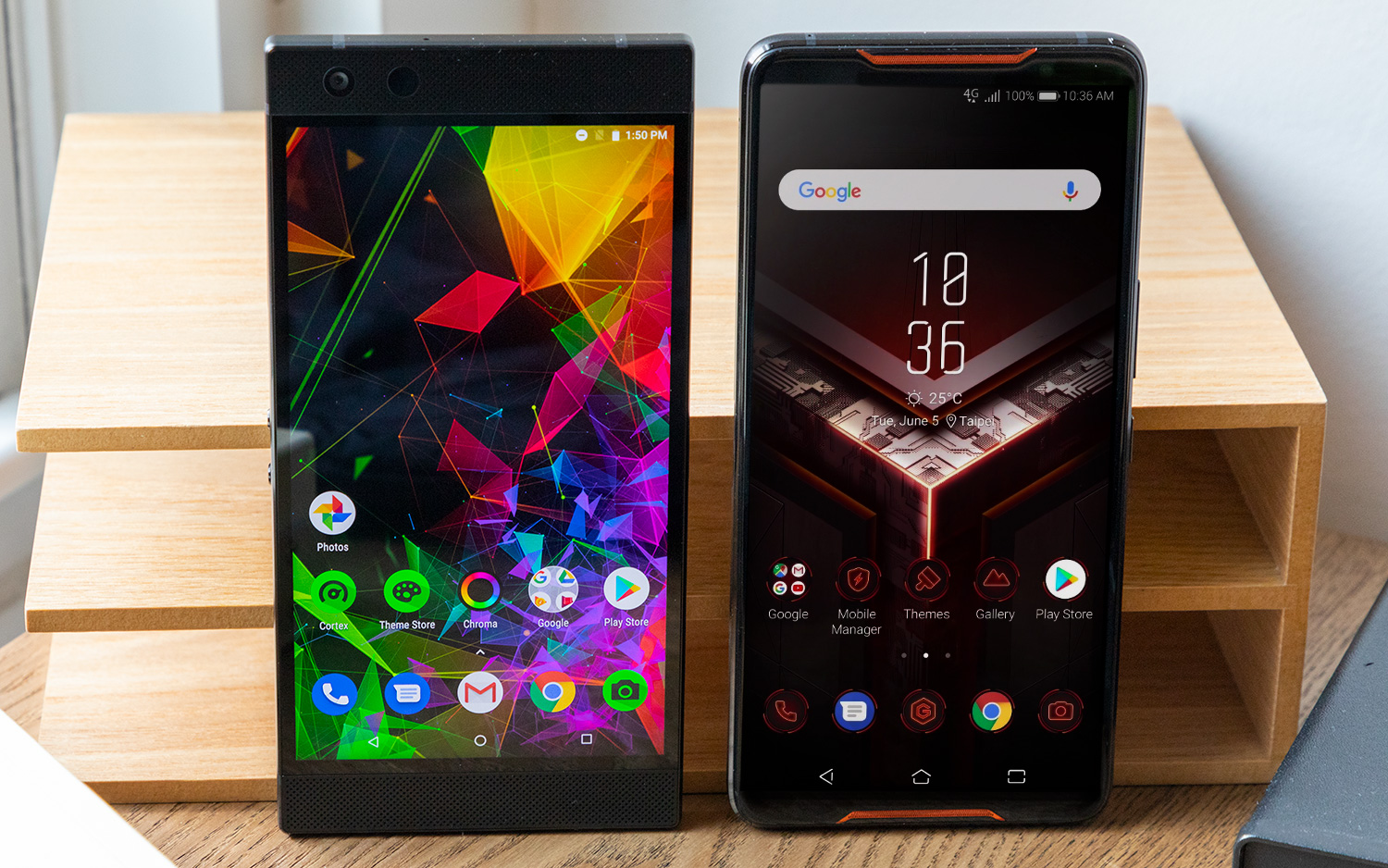
But that's nothing compared to what Razer and Asus have been working on. These two companies are no strangers to PC gaming, and now they're making a push into smartphones. Razer had a year's head start with 2017's Razer Phone, while Asus is tapping its Republic of Gamers brand for a gaming phone of its own.
Both the $799 Razer Phone 2 and $899 ROG Phone have powerful Snapdragon 845 processors, elaborate vapor-chamber cooling systems to maintain performance under stress, mesmerizing RGB lighting and displays with faster refresh rates than what you'll find in any other phone. Yet, they look completely different from each other and offer totally unique Android experiences.
Which one should discerning gamers on the go spring for? Here's your answer.
Specs
| Row 0 - Cell 0 | Razer Phone 2 | ROG Phone |
| Price | $799 | $899; $1,099 |
| OS | Android 8.0 Oreo | Android 8.1 Oreo |
| Screen Size, Resolution | 5.7-inch LCD (2560 x 1440) | 6-inch AMOLED (2160 x 1080) |
| CPU | Qualcomm Snapdragon 845 | Qualcomm Snapdragon 845 |
| RAM | 8GB | 8GB |
| Storage | 64GB | 128GB, 512GB |
| microSD Slot | Yes, up to 512GB | No |
| Rear Camera | Dual: 12 MP standard (ƒ/1.8) and 12 MP telephoto (ƒ/2.6) | Dual: 12 MP standard (ƒ/1.8) and 8 MP |
| Front Camera | 8 MP (ƒ/2.0) | 8 MP (ƒ/2.0) |
| Battery Size | 4,000 mAh | 4,000 mAh |
| Battery Life (Hrs:Min) | 7:21 | 8:59 |
| Water Resistance | IP67 | None |
| Dimensions | 6.24 x 3.11 x 0.33 inches | 6.25 x 3.00 x 0.34 inches |
| Weight | 7.8 ounces | 7.05 ounces |
Design
It stands to reason that the exteriors of the Razer and ROG phones reflect the design language of each brand's PCs. Razer's handset is sleek, monolithic and straightforward, while the ROG Phone is edgy, sharp and clad in vents, etchings and a mix of surfaces to proudly display its gaming lineage.
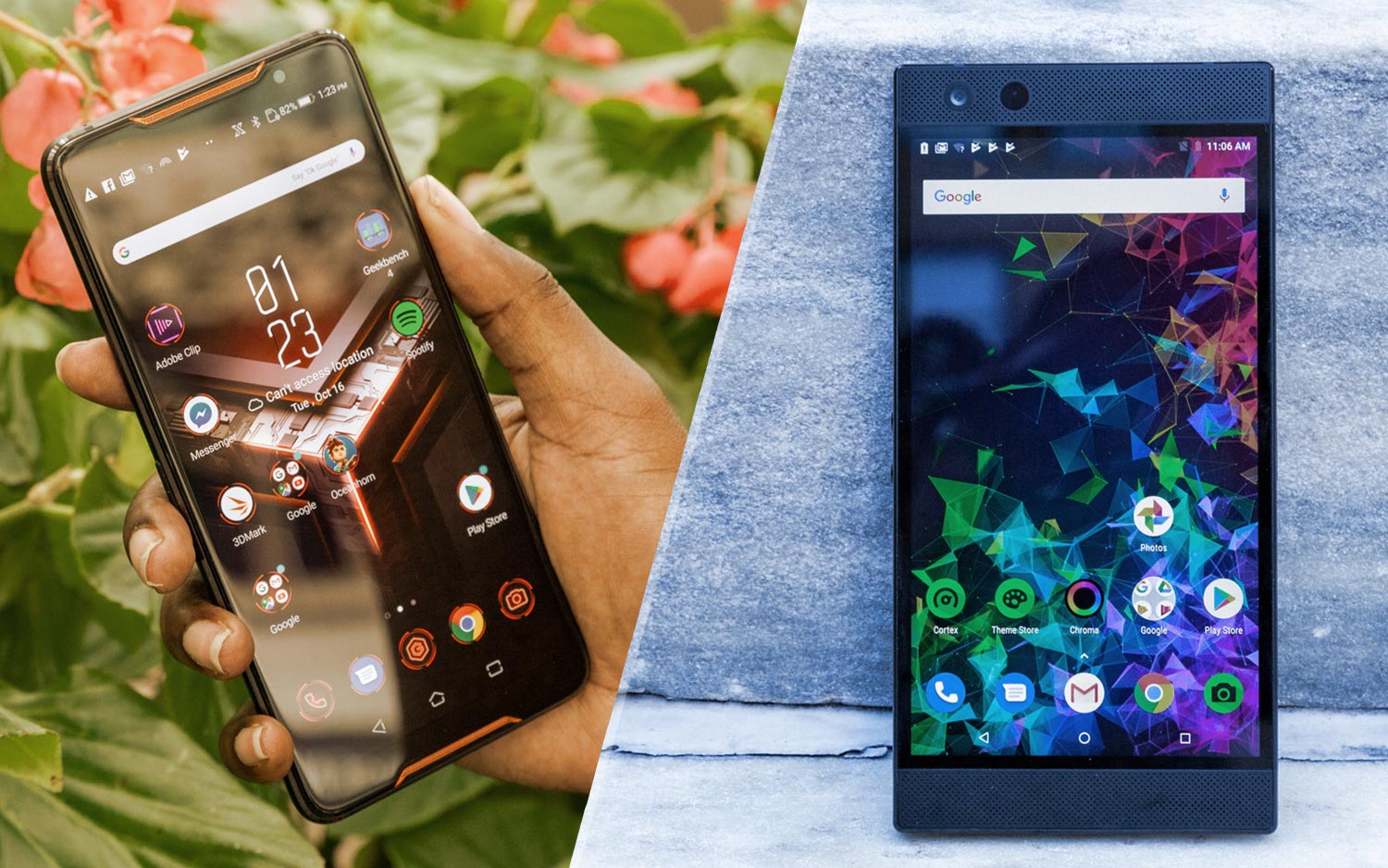
The two phones both feel admittedly dated, though in different ways. The Razer Phone 2 has a 16:9 screen and thick bezels that house the device's powerful front-facing speakers. The look is rather unconventional for a 2018 flagship, when bezel-free displays with 18:9 aspect ratios are all the rage, though I think the performance of the speakers justifies the space they take up (more on that later). Razer's phone is also very heavy, thick and large in a way that makes it more difficult to use one handed.
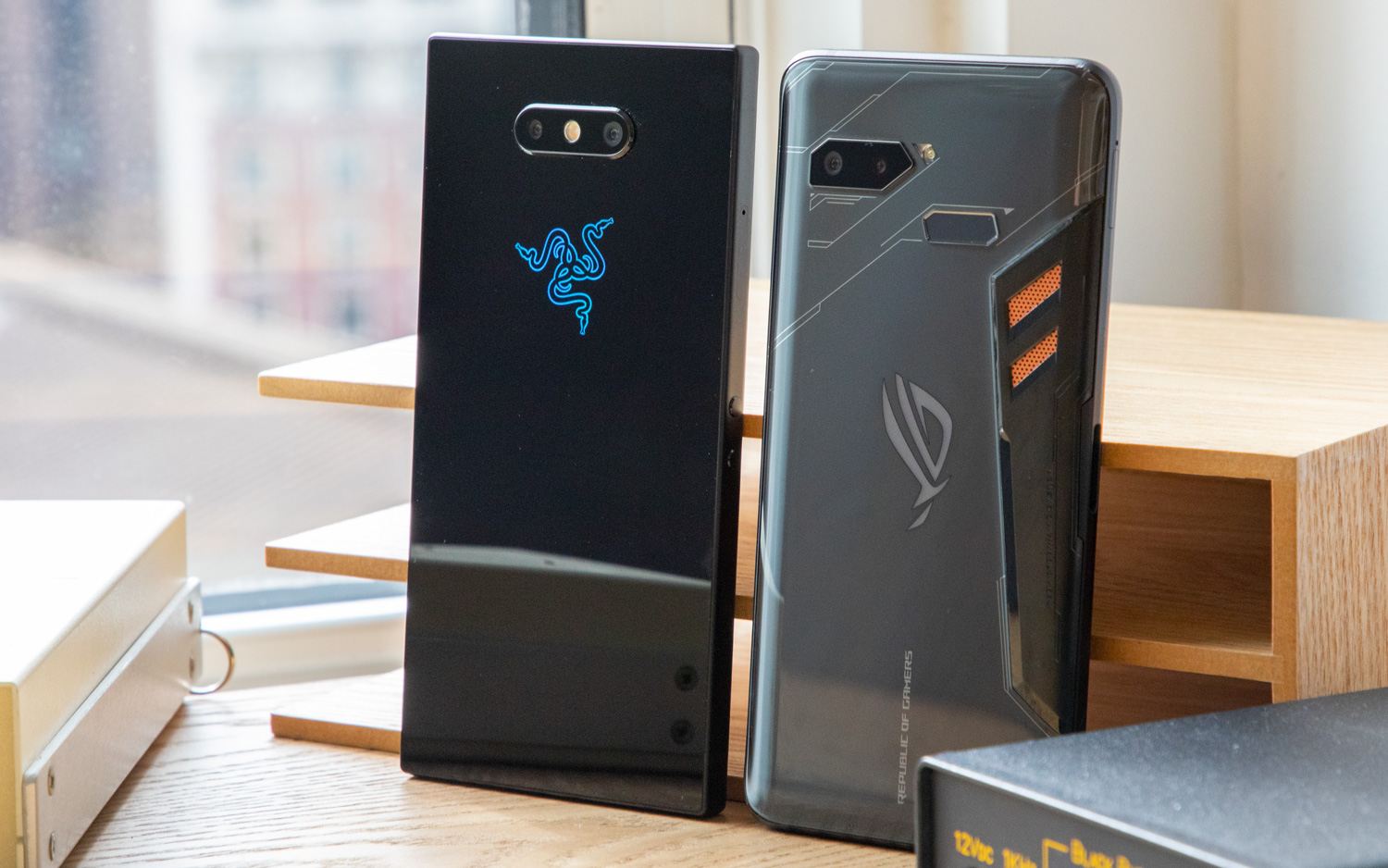
The ROG Phone is also decently chunky, but it disguises its size with smoother surfaces and 2.5D Gorilla Glass shielding the display. However, I suspect that some will find the gamer aesthetic a little juvenile, even though there are certain details that really do pop, like the copper-accented stereo-speaker grilles.
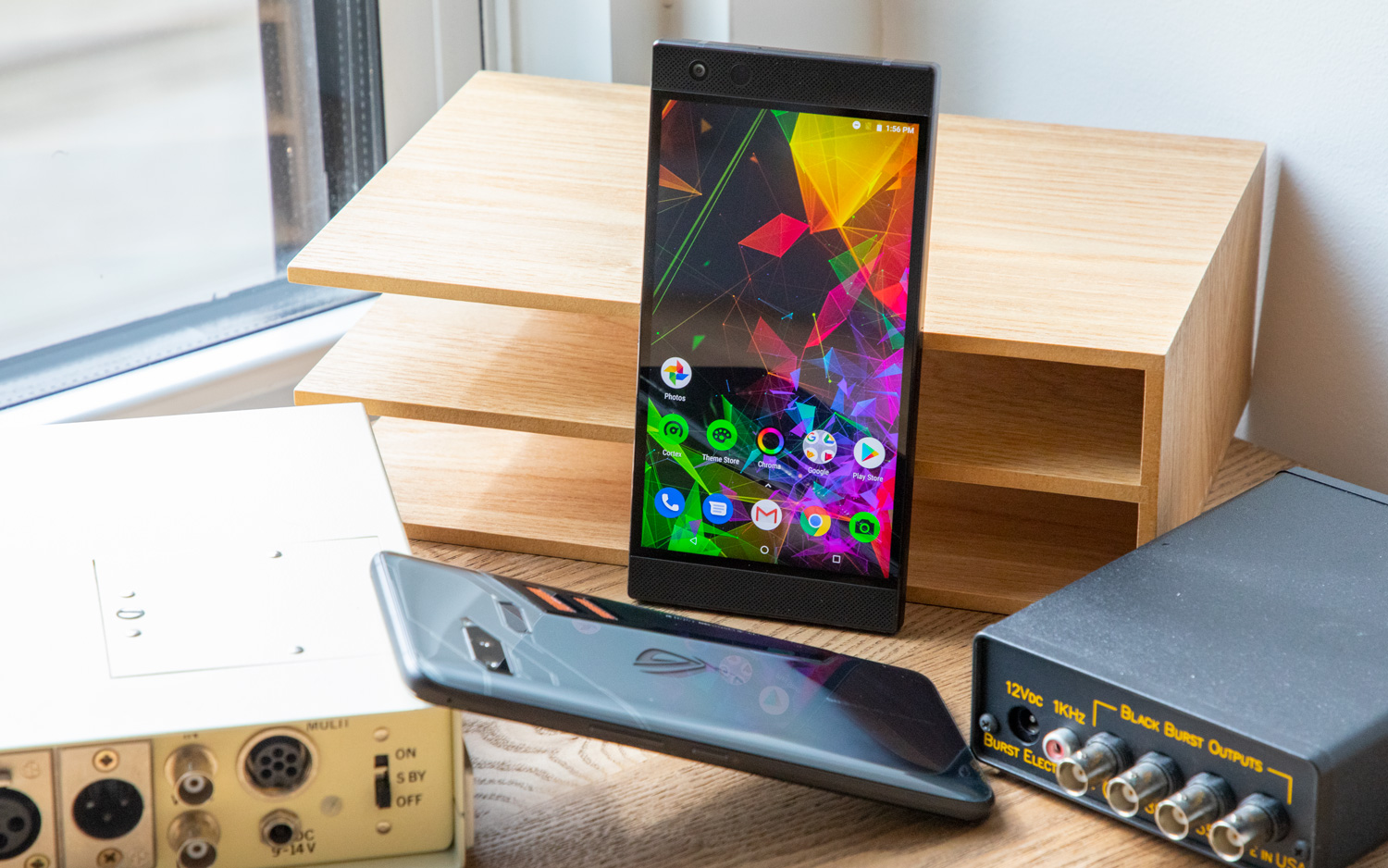
As certified gaming phones, both devices feature RGB-lighted logos with extensive customization options. However, Razer's Chroma system gives you the ability to tailor the colors on a per-app basis. Meanwhile, the ROG Phone has extra inputs called Air Triggers — basically, capacitive sensors that sit on the corners of the frame and function as remappable shoulder buttons. It's a wonderfully effective solution to the problem gamers often face on phones of lacking enough screen real estate to accommodate every button or action.
MORE: Razer Phone 2 Review Roundup: Game On or Game Over?
Ultimately, the Razer Phone is the more premium-looking and -feeling device, but Asus' handset is a little more comfortable to live and play with, thanks to those handy triggers.
Winner: Draw
Display
These two handsets take radically different strategies with their displays. The 5.5-inch Razer has a squatter aspect ratio and uses LCD in lieu of AMOLED. Those might sound like significant drawbacks, but the benefit is a faster refresh rate than you'll find on any other smartphone, at a blistering 120 Hz.
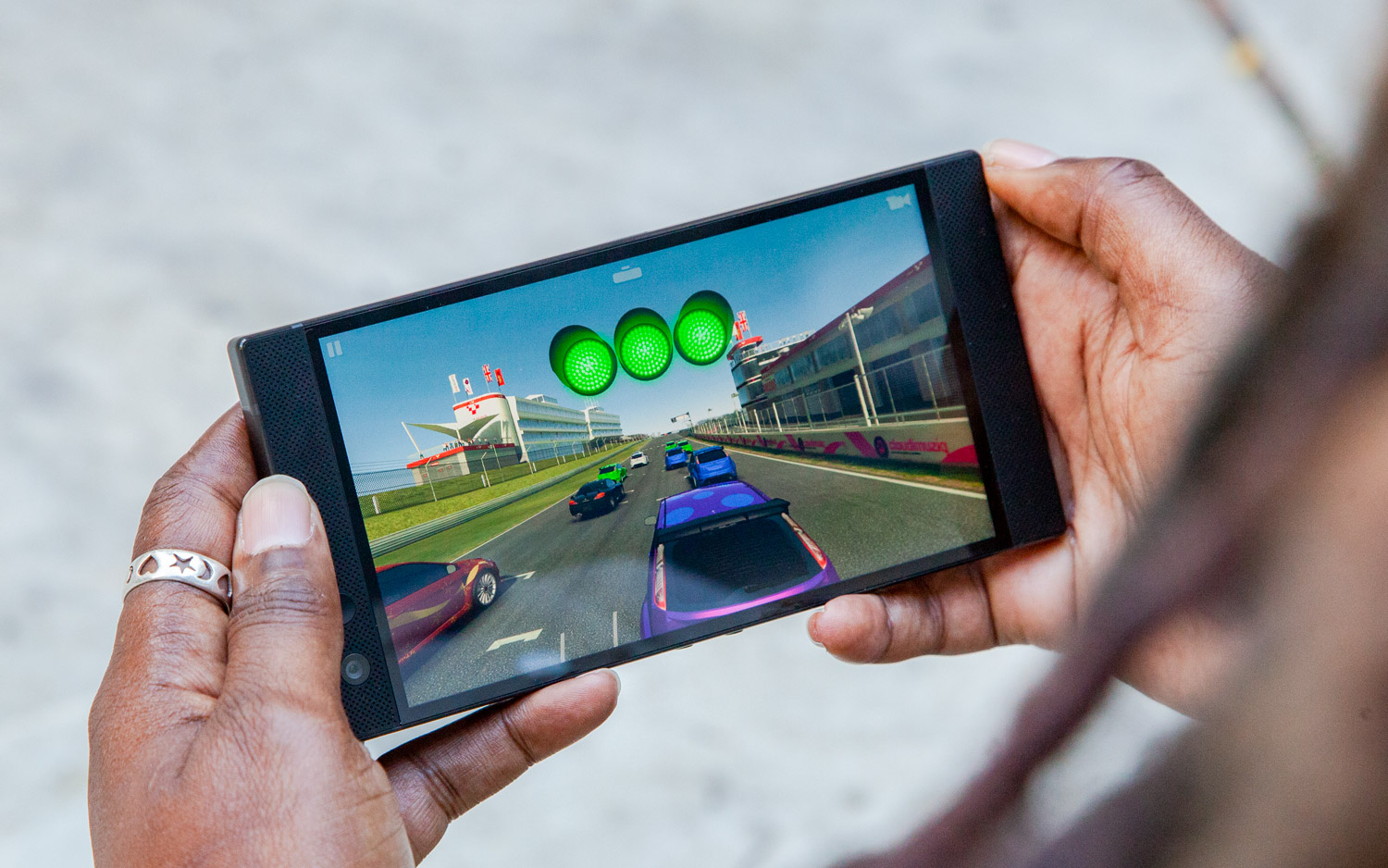
The ROG Phone's 6-inch panel still delivers smooth graphics, at 90 Hz. That's better than the standard 60 Hz, but given Asus' decision to opt for an AMOLED panel, a trade-off had to be made somewhere. Because the ROG Phone's screen is AMOLED, you'll get much more vivid color and truer blacks when watching, playing or — heaven forbid — working than you would with the Razer Phone 2's LCD panel.
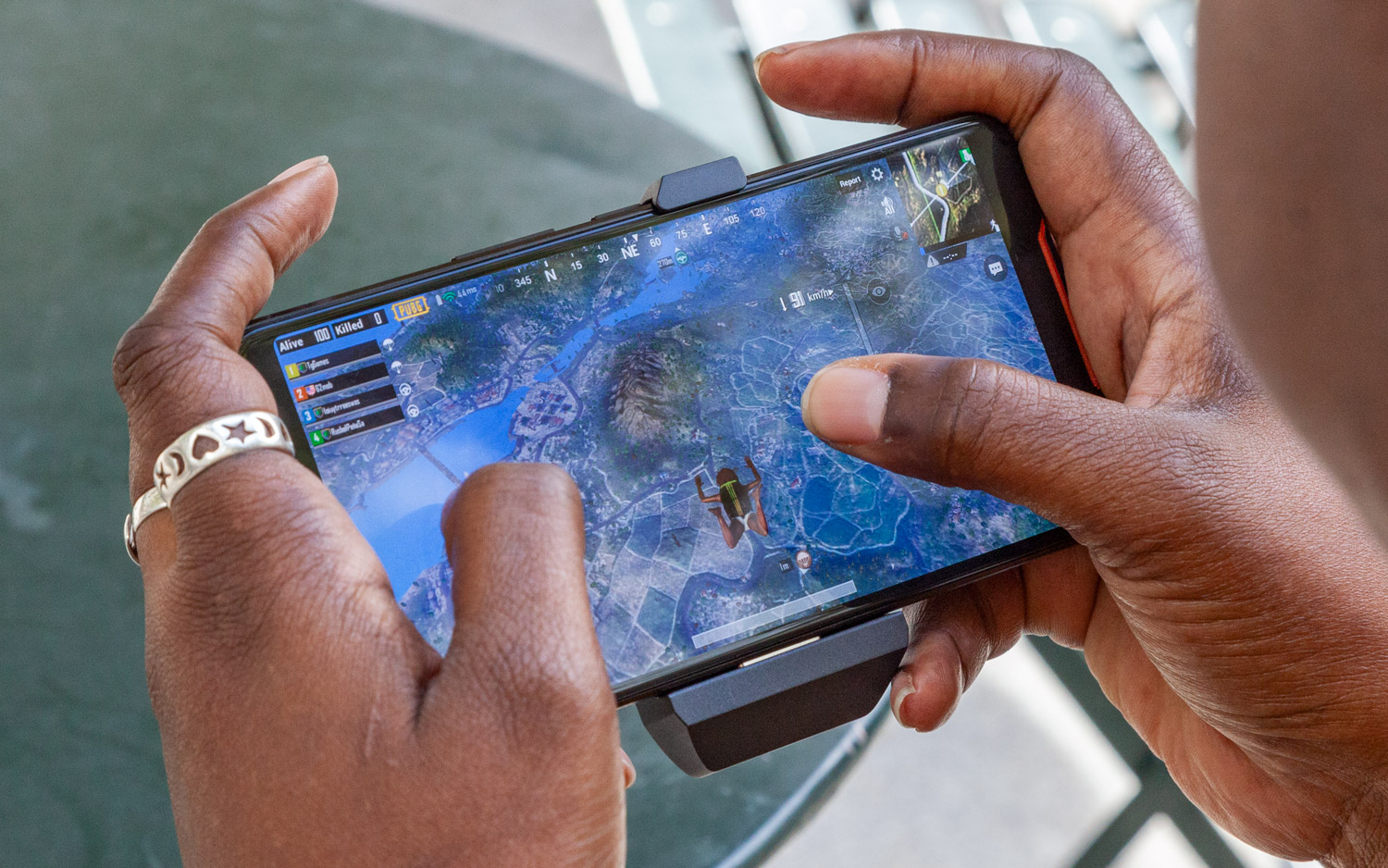
For that reason, it's not very surprising that the ROG Phone wipes the floor with the Razer Phone across all of our display-testing metrics that prioritize color over refresh rate. Asus' handset can cover 233 percent of the sRGB color space compared to Razer's 104 percent, hits a higher peak brightness (538 nits compared to 492) and paints more-accurate hues, with a Delta-E rating of 0.5 compared to 1.2. (Numbers closer to zero are better in that test.)
But the Razer Phone 2 has a superior pixel density of 512 pixels per inch, compared to the 402 ppi of the ROG Phone. And again, the Razer's display looks wonderful in motion, even when you're just swiping back and forth through home screens. With a faster refresh rate, every animation or movement on screen just feels much smoother. And as a result, Android feels remarkably more responsive on the Razer Phone 2 than on pretty much any other device.
MORE: 20 Best Android Games
Ultimately, though, the question of which display is truly better falls on what you prioritize: smoothness or color. Most of the time, we think you'll want those richer hues for viewing videos and browsing photos. Additionally, it's important to remember that the ROG Phone's display is still very snappy, at 90 Hz, so it'll still feel like an upgrade over every other handset that isn't made by Razer.
Winner: ROG Phone
Cameras
No matter which of these two gaming phones you pick up, you'll get dual-lens cameras with the ability to shoot shallow depth-of-field portraits. The Razer Phone 2 combines two 12-megapixel shooters, while the ROG Phone partners a primary, 12-MP lens with a secondary, 8-MP one. Around the front, both devices employ 8-MP front-facing sensors.
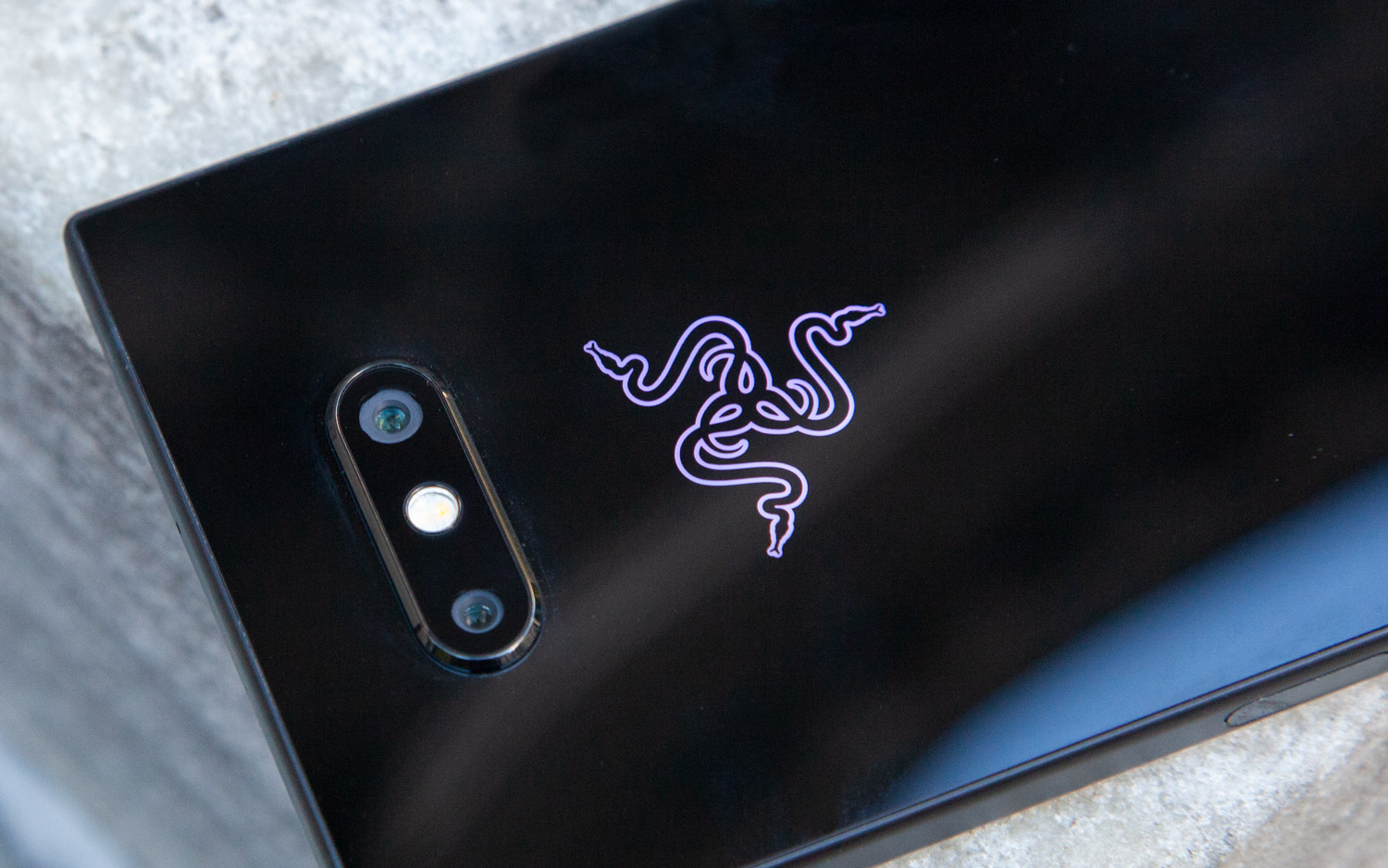
One of the biggest complaints against the first-gen Razer Phone pertained to its cameras, which had a tendency to produce washed-out images. While Razer is adamant that its latest handset incorporates Sony's best flagship image sensor and takes better pictures (especially after an early software update to further tweak the cameras), our testing indicates that the new phone hasn't totally dodged its old ways
This shot of a bed of flowers outside the New York Public Library is a perfect example of that. The Razer Phone's attempt isn't a total loss; I like the way it adds more clarity and brightness to the darker regions of the tall green leaves in the background. But the image from the ROG Phone is far better overall. It doesn't blow out the pinks and yellows in the petals, and it lends more color to the background and the library's stone walls.
The story played out similarly inside a bar at Grand Central Terminal, where the ROG Phone delivers a more vivid low-light scene with sufficient detail in the bottles and labels on the wall. The Razer Phone just can't contend with the sharpness that Asus' gaming handset conveys.
Things only got worse for the Razer Phone when I used the device's portrait mode. Frankly, Razer's example is one of the worst bokeh-effect portraits I've ever seen from a flagship-caliber phone. My colleague Caitlin's face is so fuzzy in this shot, that she almost blends seamlessly into the blurred background. The picture from the ROG Phone is hardly perfect, with its dim exposure, though at least it keeps her in focus.
Finally, Asus' selfie game is visibly stronger than Razer's, as the ROG Phone proves with its crisper focus and more-accurate white balance. The Razer Phone 2 deemed it necessary to paint me orange for some reason, a creative liberty I personally wouldn't have taken. As with all the other examples, there really isn't any contest here.
Winner: ROG Phone
Performance
The ROG Phone holds a slight advantage in the specs race. While this phone shares the same Snapdragon 845 CPU you'll find inside the Razer Phone 2, Asus has gone so far as to overclock Qualcomm's silicon for its handset.
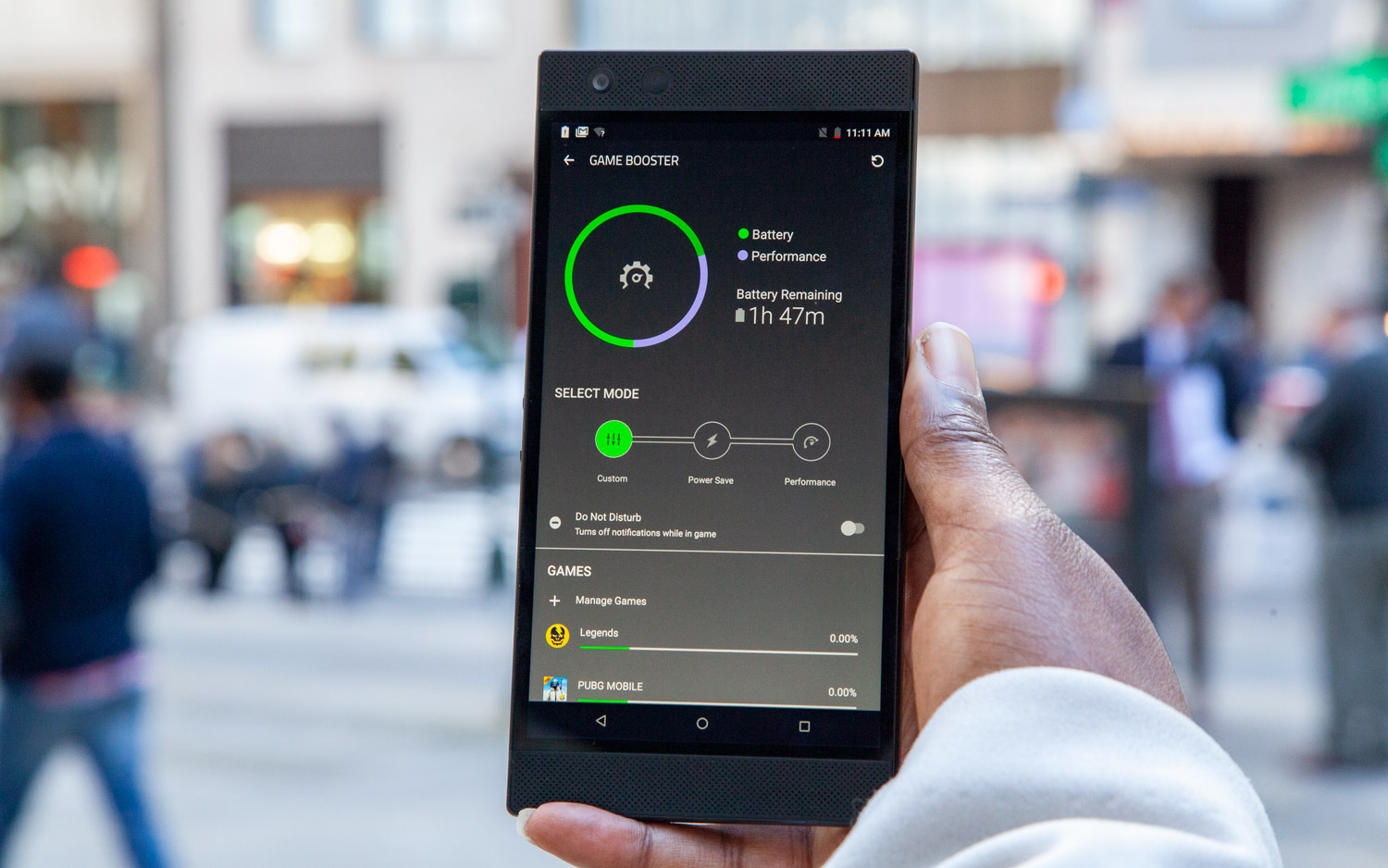
Mind you, the ROG Phone doesn't always run in this sped-up state; you'll see peak performance only when running the device's X Mode, which diverts all system resources toward the game in front of you.
Still, the ROG Phone's slight bit of headroom helped it edge the Razer Phone 2 in Geekbench 4 testing, where Asus' device turned in a score of 9,224 compared to Razer's 8,903. Additionally, the ROG just ever-so-slightly sneaked by the Razer Phone in 3DMark's Sling Shot Extreme graphics gauntlet, in which the handsets finished with scores of 4,757 to 4,621, respectively.
This wasn't a significant enough difference to really be a factor when I was gaming, however. Both devices handled corridor shooter Shadowgun Legends very well, never slowing down even when the game threw hordes of cyborgs in my direction at once.
MORE: 100+ Great iOS Games for iPhones and iPads
The ROG Phone proved a hair faster in other real-world applications, though. During our video-encoding test, in which a 2-minute 4K video file is converted to 1080p using Adobe's Premiere Clip app, the ROG Phone finished in 3 minutes and 31 seconds, compared to the Razer Phone's 3 minutes and 59 seconds.
Winner: ROG Phone
Battery
The ROG Phone outpaced the Razer Phone 2 by about an hour and a half in our battery test, in which we had both phones cycle through loading web pages over T-Mobile's LTE network until their batteries ran dry. The ROG Phone lasted 8 hours and 59 minutes, while the Razer Phone called it quits after just 7:21.
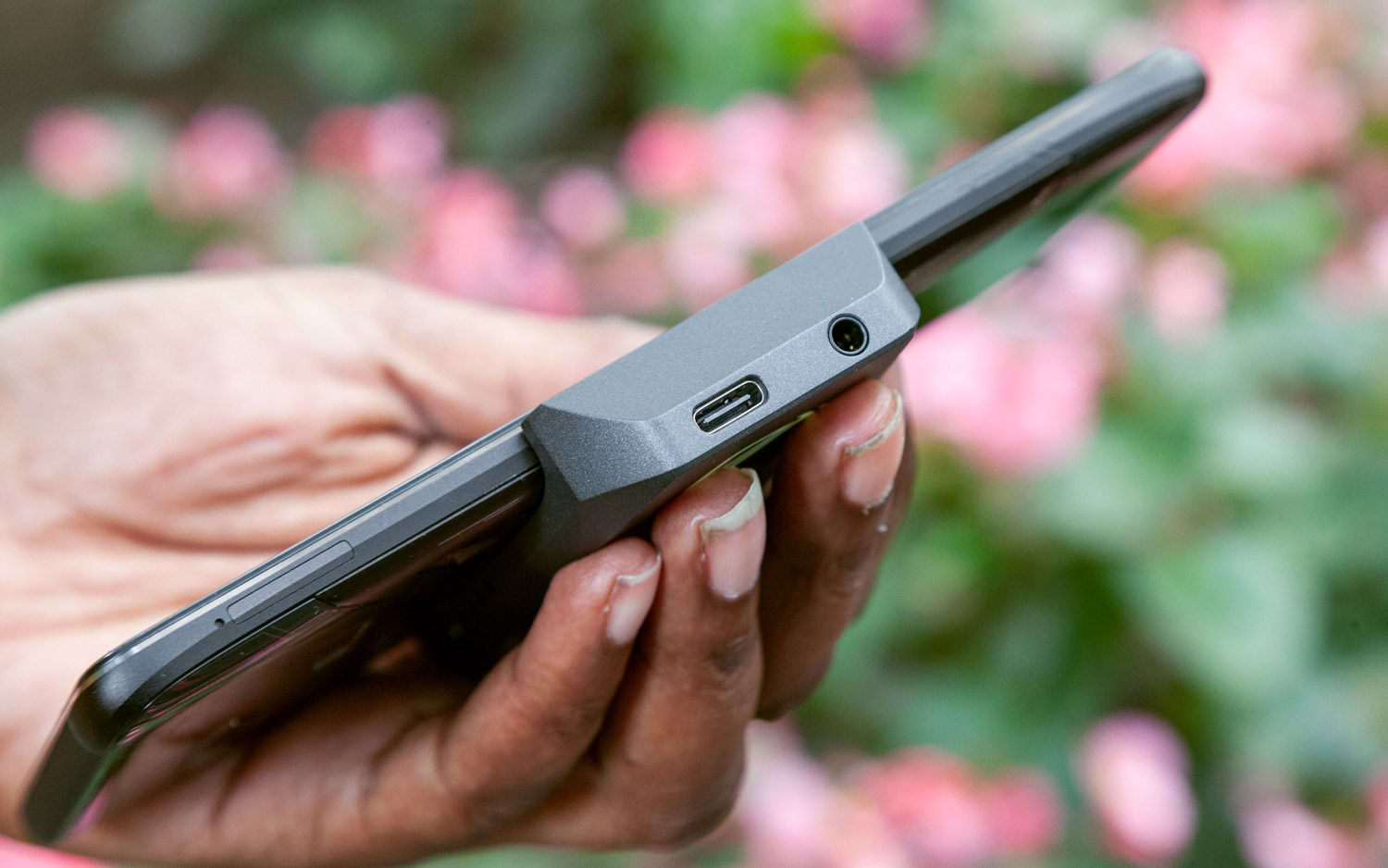
However, Razer does have one leg up on Asus in the battery game: The Razer Phone 2 can charge wirelessly. This device is compatible with all standard Qi chargers, though Razer also sells a $99 wireless charging dock enhanced with Chroma lighting. Owners should note, though, that Razer has mounted the coil in an abnormally low location, which might make using third-party pads a little more difficult.
Winner: ROG Phone
Software
Asus' and Razer's handsets both launch with Android 8.1 Oreo, though they go about implementing Google's OS in very different ways. The Razer phone comes across as more of a stock experience (differentiated only by Razer's black-and-green color scheme and some light changes to things like the camera app), while the ROG Phone employs ZenUI, Asus' custom Android front end.
I've long found ZenUI to be the embodiment of everything I personally dislike about the worst Android skins. It doesn't look particularly good; it changes lots of typical Android behaviors for change's sake alone, and it can at times feel confusing and overwhelming to navigate. All of those things are true of the ROG Phone, though on top of that, Asus has further re-skinned its skin to look more gamer-friendly and match the device's edgy exterior.
Both companies have pledged that they will soon update these models to Android 9 Pie, though the ETA is anyone's guess at this point.
Winner: Razer Phone 2
Accessories
The ROG Phone does better in the sheer number of accessories it offers. There's a Desktop Dock that transforms the phone into a mini PC with loads of ports (even including an SD card reader), a special controller-and-dock tandem that Asus says guarantees zero latency, a Twinview Dock that transforms the handset into the Android equivalent of a Nintendo 3DS (and adds a 6,000-mAh battery) as well as a clip-on cooling fan to bolster the device's performance during particularly demanding gaming sessions.
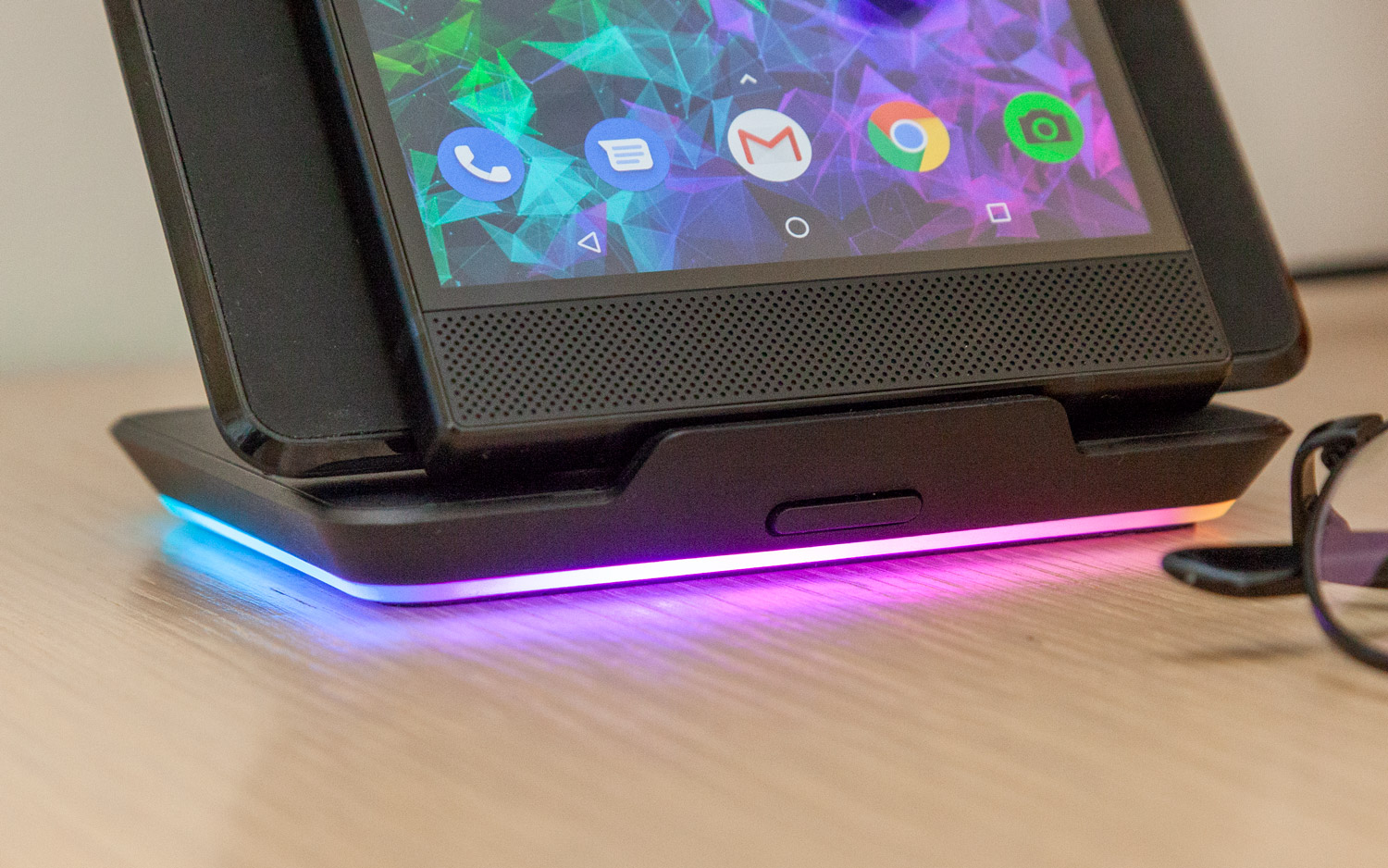
Razer doesn't offer anything of the sort for its phone, though Asus' roster of add-ons is so expensive (most of those docks are priced at $200 or more) and of such dubious value, that it's not the greatest loss. Ultimately, though, the ROG Phone wins points for its modularity.
Winner: ROG Phone
Price and Availability
At $799, the Razer Phone 2 isn't just cheaper than the $899 ROG Phone; it's cheaper than the majority of flagships out there, period. Razer deserves props for hitting such a competitive price given the strength of the device's specs. And to make the value proposition even better, Razer is working hard to get the device certified for CDMA carriers like Verizon, as well as GSM ones. That means that soon, you'll be able use Razer's device on any network of your choice in the U.S. The ROG Phone, by comparison, starts at $100 more and runs on only GSM towers, like AT&T's and T-Mobile's.
The Razer Phone 2 comes in only one, 64GB storage configuration, though there is a microSD slot that will allow you to tack on up to another 512GB. The ROG Phone does give you 128GB for the extra money you're spending, though there's no expandability. If you want the 512GB option, you'll have to spend $1,099.
Winner: Razer Phone 2
Overall Winner: ROG Phone
The best gaming phone still has to be a great phone overall. And Asus' ROG Phone outperforms the Razer Phone 2 in almost every category.
| Row 0 - Cell 0 | Razer Phone 2 | ROG Phone |
| Design (10) | 7 | 7 |
| Display (15) | 10 | 13 |
| Cameras (20) | 8 | 13 |
| Performance (10) | 8 | 9 |
| Battery (20) | 10 | 13 |
| Software (10) | 8 | 7 |
| Accessories (5) | 2 | 4 |
| Value and Availability (10) | 8 | 5 |
| Overall (100) | 61 | 71 |
The ROG Phone's cameras aren't perfect, but they're much better than those in the Razer Phone. Ditto for the battery life, as well as the ROG Phone's overclocked performance and OLED display.
Unfortunately, though, the ROG Phone is a bit pricier and isn't available across the same breadth of carriers. That will surely put the device out of the reach of some consumers. If that's the case for you, the Razer Phone 2 is a good alternative. But the ROG Phone is just a little bit better in a bunch of small ways, and those small ways add up.
Credit: Tom's Guide
Sign up to get the BEST of Tom's Guide direct to your inbox.
Get instant access to breaking news, the hottest reviews, great deals and helpful tips.
Adam Ismail is a staff writer at Jalopnik and previously worked on Tom's Guide covering smartphones, car tech and gaming. His love for all things mobile began with the original Motorola Droid; since then he’s owned a variety of Android and iOS-powered handsets, refusing to stay loyal to one platform. His work has also appeared on Digital Trends and GTPlanet. When he’s not fiddling with the latest devices, he’s at an indie pop show, recording a podcast or playing Sega Dreamcast.
